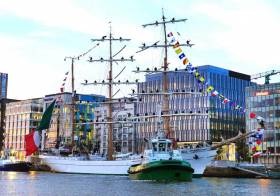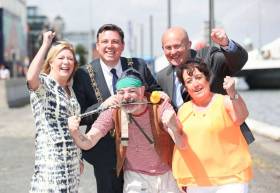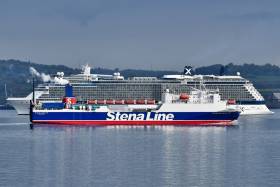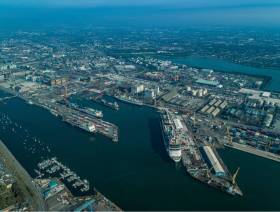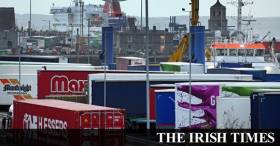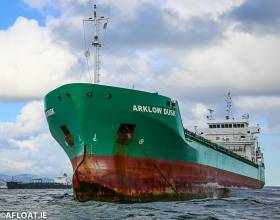Displaying items by tag: Dublin Port
Plan for No-Deal in Irish Ports Still Not Tested With Only 37 Days Left
Systems newly designed to avoid chaotic scenes at Irish ports and airports in the event of a no-deal Brexit have not yet been trialled.
With only 37 days until the potential worst-case scenario, the plans reports the Independent.ie, have yet to be road-tested.
Dublin Port has a contingency plan, known as Operation Purge, which is designed to ensure minimum traffic congestion in the city if trucks get delayed by checks.
However, Fianna Fáil Brexit spokesperson Lisa Chambers claims the fact it and other contingency operations have not been trialled "is reckless".
To read more on comments made by Chambers, click here.
Politicians Visit Dublin Port & UK's Largest Energy Port Against Backdrop of Brexit Preparedness
In advance of the UK's prime minister Boris Johnston meeting today in Dublin, it was also reported on RTE News of yesterday's visit by Leo Varakar to Dublin Port where the Taoiseach viewed the €30 million investment that has been put in place to prepare for a possible no-deal Brexit.
While on the other side of the Irish Sea politicians recently paid a visit to the Welsh Port of Milford Haven to view operations at the UK’s largest energy Port.
According to the Milford Haven Port Authority, the Parliamentary Under-Secretary of State for Wales Kevin Foster MP was joined by Stephen Crabb MP and Paul Davies AM for a tour of the Pembrokeshire port located in south-west Wales.
The party were taken on a tour of the Waterway onboard a pilot vessel, hosted by the Port’s Chief Executive Andy Jones, Chairman Chris Martin and Harbourmaster Mike Ryan, where they were able to discuss the Port’s vital role as an important hub of regionally and nationally significant economic activity and employment. Naturally this included topics such as Brexit preparedness and the potential opportunity, post-Brexit, for the Port of Milford Haven to be designated as a Freeport.
As supporters of Pembroke Dock Marine which aims to anchor wave, tidal and floating wind renewable energy developers in Pembrokeshire, the Minister, Stephen and Paul were also keen to hear how that project was progressing as part of the Swansea Bay City Deal.
Andy Jones, Chief Executive at the Port of Milford Haven, discussed the potential impact that 0% import tariffs on petrol will have on UK refineries with the Minister. “Not only is Valero a national asset,” said Andy, “in Pembrokeshire it plays a critical role in supporting an otherwise rural economy and is one of Pembrokeshire’s largest employers. Post Brexit, providing the necessary conditions for continued business investment of businesses like Valero in the face of global competition will be essential in order to secure the viability of the energy cluster here”.
“We welcomed the opportunity to share our thoughts on the idea of Milford Haven being designated as a Freeport and expanded on that idea to develop the concept of a Port Zone” continued Andy. “Port Zones would include accelerated regulatory processes. Prioritising Port Zones would also help reduce investment risk and uncertainty and make the Port a more attractive proposition for potential global investors.”
“The UK Government has a vision for Freeports to boost investment, drive innovation, attract high skill jobs, support free enterprise and drive growth in left-behind areas across the UK,” continued Andy “and while Freeports tend to be associated with general purpose manufacturing and logistics, the Port of Milford Haven’s internationally significant energy sector offers a unique opportunity.”
“As the UK’s leading energy port with its cluster of anchor businesses, excellent grid connectivity and world-class supply chain, the Port of Milford Haven would have a strong competitive advantage attracting relevant investment opportunities were it to be a Freeport. A Freeport designation, aligned with the Haven Waterway Enterprise Zone, would seek to support UK oil and gas refining and processing capacity as it competes for global foreign direct investment, restore fish processing capability and support tidal and wave energy development to name a few of the potential opportunities.”
UK Government Minister for Wales Kevin Foster said: “It is fantastic to see the Port of Milford Haven developing plans for a world class centre for marine energy, attracting inward investment and creating more highly skilled jobs. I look forward to working closely with the Port and Welsh Government to develop this project as part of the Swansea Bay City Deal, generating transformational growth across the region.”
Mexican Tall Ship Arrives in Dublin
Dublin Port Company and the Mexican Embassy in Dublin have welcomed one of the world’s largest Tall Ships, the 270-foot-long Cuauhtémoc, which sailed into Dublin early this morning for a five-day visit to the capital. She is berthed at Sir John Rogerson’s Quay for the duration of her stay, and open to the public to visit, free of charge, on the following dates and times:
- Friday, 6th September, from 11.00am to 8.00pm
- Saturday 7th September, from 11.00am to 8.00pm
- Sunday 8th September, from 11.00am to 8.00pm
- Monday 9th September, from 11.00am to 8.00pm
Having arrived from Hamburg, Dublin is the second-last stop on the ship’s 250-day training voyage of Northern Europe involving visits to 15 ports in 10 different countries (Canada, United Kingdom, France, Netherlands, Denmark, Norway, Germany, Ireland, Spain and Colombia).
Led by Commanding Officer Captain Carlos Gorraez Meraz, the Cuauhtémoc is an official sail training vessel of the Mexican Navy which travels around the world carrying a message of friendship and goodwill. This is the Cuauhtémoc’s fifth visit to Irish waters since her maiden call in 1998. She subsequently visited the capital in 2008, in 2012 as part of the Tall Ships festival and again in 2015.
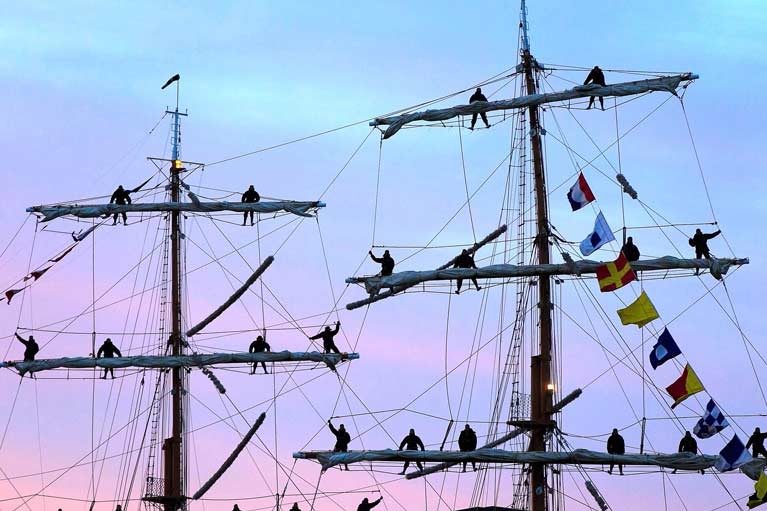 The Mexican tall ship opens to the public to visit, free of charge, from Friday 6th to Monday 9th September at Sir John Rogerson’s Quay (11am to 8pm daily). Photo: Shane O'Neill
The Mexican tall ship opens to the public to visit, free of charge, from Friday 6th to Monday 9th September at Sir John Rogerson’s Quay (11am to 8pm daily). Photo: Shane O'Neill
Members of the public visiting the ship this weekend will be able to get a closer insight into life on board for the 257-strong crew and inspect the fine craftsmanship of the vessel which has trained more than thirty generations of officers, cadets, petty officers and sailors, both Mexican and other nationalities.
Commenting on the tall ship’s visit, The Ambassador of Mexico to Ireland, H.E. Miguel Malfavón said; “For over 40 years, Mexico has enjoyed excellent diplomatic relations with Ireland built on a shared sense of history and strengthening cultural, academic and trading ties in the present day. The arrival of the Cuauhtémoc reminds us of the affinity and friendship that exists between our two nations and symbolises the hand of friendship from Mexico to Ireland. For most of the crew on board, this is their first visit to Ireland, marking a new generation of Mexican-Irish exchange.”
Encouraging members of the public to visit over the weekend, Eamonn O’Reilly, Chief Executive, Dublin Port Company, said; “Tall Ship visits to Dublin are always a highlight and the Cuauhtémoc is no exception. This is a spectacular vessel and one of the finest working tall ships at sea today. I would encourage people in the city to take a trip down to Sir John Rogerson’s Quay to explore the Cuauhtémoc over the weekend and show her a warm Irish welcome during her stay. She brings a little piece of Mexico to our doorstep and it’s an opportunity not to be missed.”
Built in the Celaya shipyards in Bilbao, Spain, the Cuauhtémoc was launched in July 1982. She was the last of four windjammers built by Bilbao shipyards and is named after the last Aztec Emperor who was imprisoned and executed by the conquistador, Hernán Cortés, in 1525. This is her fifth visit to Irish waters.
Europort: Is Rosslare Ready for Brexit?
The WexfordPeople writes, following his visit to Wexford to officially open the M11 Gorey to Enniscorthy bypass, pictures were circulated of a smiling Taoiseach Leo Varadkar meeting with representatives at Rosslare Europort.
Having shed his tie after a long day, there were smiles nonetheless as he was shown around the Port which he's publicly stated as being key to post-Brexit Ireland.
However, decades of neglect means getting things up to code is a mammoth task, particularly with a Brexit deadline of October looming large. With a €320million expansion plan being outlined for Dublin Port, critics have accused the government of merely paying lip-service to Rosslare and are not holding out too much hope that it will get the shot in the arm it needs.
General Manager at the port Glenn Carr, however, remains firm that Brexit should represent an opportunity for Rosslare.
More on the story can be read through this link.
South Docks Festival in Dublin Celebrates Community
This month's South Docks Festival in Dublin is celebrating community and heritage and taking pride in the identity inherent in the South Dublin Docklands area.
This year’s festival is run by staff and volunteers at St. Andrew’s Resource Centre in collaboration with local communities around Pearse Street, Westland Row and City Quay.
More on the festival here
Dublin Port Ban Could Bring Fears Signalling An 'End of an Era' for Cruiseships in Belfast
An enormous cruiseship Celebrity Reflection sails into Belfast this morning, bringing thousands of deep-pocketed North Americans to the city's visitor attractions, shops, pubs and restaurants, there are fears it could be the 'end of an era' for this type of tourism.
As The Irish News reports, it comes as the Dublin Port Company sticks to its guns and restricts the number of cruise ships entering its port from 2021 as it increases freight capacity container vessels post-Brexit.
And when cruise ships can't dock in Dublin, then Ireland as a whole could be wiped from tour itineraries - which will impact heavily on Belfast.
In what is known in the industry as a 'turnaround', the Celebrity Reflection dropped off 3,600 cruise tourists in Dublin yesterday while another 3,600 passengers flew into Dublin to begin their cruise, which has Belfast as its next stop today.
Dublin port sees freight (where volumes have swollen by 36 per cent in six years) as more lucrative than cruisers, and last month confirmed the number of tour vessels it will allow to berth will be slashed from 172 in 2019 to as few as 30 in just two years.
Click here to read more on the story.
Large Cruiseship Signals ‘End of an Era’ for Irish Cruise Tourism Following Dublin Port Cruise Ban
#cruiseliners - The arrival of thousands of well-travelled North American visitors on a huge cruiseship today could signal the ‘‘end of an era’’ due to actions of the Dublin Port Company, that's according to a group of businesses from across the tourism, retail and transport sectors.
The All-Ireland Cruise Ship Action Group (AICSAG) which was formed to campaign against the ban on cruiseships entering Dublin Port from 2021 has welcomed the influx of visitors due to the arrival of cruiseship Celebrity Reflection in the port today. (Afloat adds even larger capacity cruiseships have docked in the port previously).
Celebrity Reflection which holds 3,600 high-spending passengers from North America, is in Dublin for a ‘turnaround’, an industry term used when one group of passengers leave a cruise ship after a cruise and fly out of Ireland while another group of passengers jet into Dublin to join for a new cruise. Many of these high net worth individuals continue to spend time on the island of Ireland after their cruise ends.
According to AICSAG, turnarounds are believed to be worth up to €100 million to the Irish tourism industry but have now been banned by the Dublin Port Company.
Up until recently, the Dublin Port Company have been extremely active in promoting cruise tourism and were actively marketing to international cruise lines, such as Celebrity.
The decision by the Dublin Port Company to stop cruise ships docking at Dublin Port from 2021 was according to the Group taken without any consultations or engagement with the Minister for Transport, Tourism and Sport, local businesses, Dublin City Council, or the other Irish ports, namely Belfast, Waterford and Cork, who will be severely impacted by this decision.
Cruise companies market Ireland as a destination, and in addition to Dublin large cruise ships often stop off at Belfast, Waterford and Cork. Without access to Dublin Port, cruise companies will no longer stop in other Irish ports and will take hundreds of thousands of passengers out of Ireland to other European destinations.
Afloat.ie today contacted Dublin Port Company which issued the following statement in response to AICSAG.
The berth restrictions we are introducing in 2021 are intended to last three years (i.e. from 2021 to 2023) while we undertake major construction works on a 400 metre quay wall, Alexandra Quay West. (Afloat adds this quay forms part of Alexandra Basin).
As regards the long-term, we have planning permission to develop new berths suitable for cruise ships immediately east of the Tom Clark Bridge [East-Link] at an estimated cost of €100m. This is the subject of a cost benefit analysis study which is currently underway and which will be finished by mid-year.
We intend publishing this study as part of a public consultation process (including with the cruise industry) to ensure that a €100m investment by Dublin Port would be viable. Subject to the outcome of this process, the new berths would be constructed in 2024 / 2025 and be available in 2026.
In addition to the statement, DPC has supplied Afloat.ie with a Briefing Document for the Minister for Transport Shane Ross on Dublin Port’s new cruise ship berthing and pricing policy.
The detailed document published in March, covers many aspects including the Alexandra Basin Redevelopment Project (ABR) and as alluded above new cruise berths [at the North Wall Extension] available in 2026.
#ferries - The Port of Holyhead has shown “no sense of emergency” about Brexit, while Dublin Port bemoaned the huge expense preparing for a no-deal exit that might not happen, the British-Irish Parliamentary Assembly heard.
As The Irish Times writes at the biannual gathering of Irish and UK parliamentarians heard details of a report from one of its committees on a visit to the two Irish Sea ports by a delegation from the assembly to assess preparations for Brexit.
The committee painted a contrasting picture on preparations being taken in Dublin and Holyhead.
Darren Millar, a Conservative member of the Welsh national assembly, said that Dublin Port officials expressed concern about the number of customs officials that still needed to be hired to deal with a potential no-deal Brexit.
“Our biggest concern was that there was huge effort and huge expense going into these things and they may not be required,” he said on Tuesday, the second day of the assembly at Druids Glen in Co Wicklow.
Further reading on this story can be read through this link.
#cruiseliners - Shane Ross the Minister for Transport has sought to reassure DUP leader Arlene Foster that Cork and Belfast would fill the gap left by Dublin Port’s reduction in cruise ship arrivals.
As The Irish Times writes, Mr Ross wrote to the Northern Irish politician last month after she expressed concern that cruise liners may decide not to dock at Belfast Harbour if Dublin limited berth space for cruise ships due to construction work.
In his letter to Ms Foster, the Minister set out detailed conversations he had with the Dublin Port Company about its plans to reduce the number of cruise ships it can accommodate while it redevelops part of the port.
He told the DUP leader that while the port’s reduction in cruise business – from about 150 to 80 cruise ship arrivals a year from 2021 to 2023 – was “regrettable”, he welcomed the port’s intention to build cruise calls back to 150 ships in 2024 and 2025, rising to more than 200 arrivals after 2026.
For much more including comments from the politicians and a cruise campaign group click here.
#dublinbay- It was a busy scene in Dublin Bay during the May Bank Holiday as up to seven ships were at anchorage among them an Irish flagged cargo which stood out with its distinctive green painted hull, writes Jehan Ashmore.
The ship Arklow Dusk is the fourth and final of a quartet of 11,000dwt sisters acquired last year by Arklow Shipping following the bankruptcy of the Dutch based Flinter Group in 2016. The remaining sisters include Arklow Dawn, Dale and Day.
Acquisition of the former Flinter America and fleetmates as secondhand tonnage is unusual for ASL as the Co. Wicklow based company notably in recent years have taken delivery of newbuilds of various designs from Dutch and German shipyards.
Arklow Dusk had previously docked in Dublin Port after a voyage from Bilbao, Spain. On board was a cargo of cement products that were discharged alongside Ocean Pier. This was the first time the 132m double-hold cargoship made a call to the capital.
On completion of unloading, Arklow Dusk proceeded 'light' to Dublin Bay to anchor in the early hours of Thursday night. On the Bank Holiday Monday, the arrival of cruiseship Norwegian Pearl stood out and as the inaugural caller of the season to Dun Laoghaire Harbour.
The presence of these seven ships on Monday was short lived as by mid-morning Arklow Dusk having awaited orders departed. The 'D' class ship was bound again for Spain but this time to Carino located in north-west of the Iberian nation.
As Arklow Dusk set a southbound course along in the opposite direction came Schelde Highway from Zeebrugge, Belgium. The vehicle-carrier headed into the bay to occupy the same area where the Arklow-registered cargoship had taken up anchorage for more than four days.



























